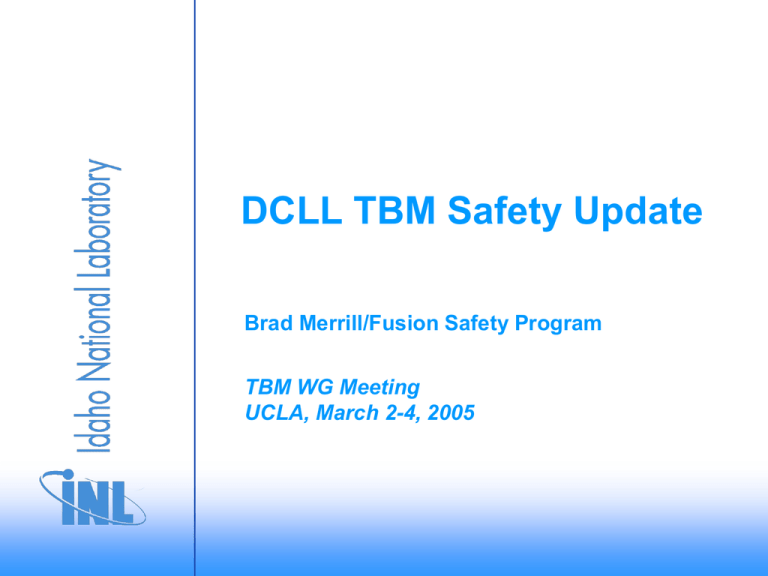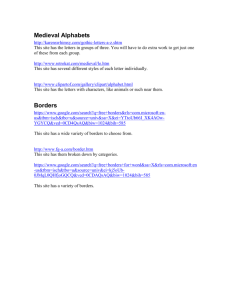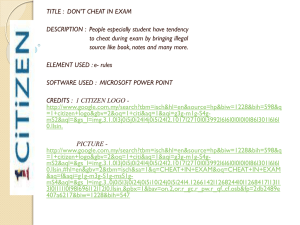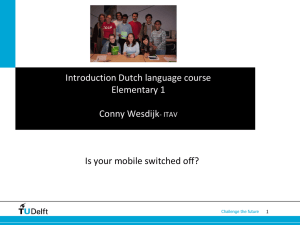TBM Safety Update
advertisement

DCLL TBM Safety Update
Brad Merrill/Fusion Safety Program
TBM WG Meeting
UCLA, March 2-4, 2005
Presentation Outline
• Discuss General Safety Requirements for test blanket modules
(TBMs)
• Present MELCOR model developed to analyze accidents for the
dual cooled (DC) TBM
• Discuss Reference Accidents that must be addressed by the DC
TBM Design Description Document (DDD)
• Describe ITER IT analysis specifications and present MELCOR
results for each accident case
• Present TMAP permeation model developed for the DC TBM and
the predicted operational permeation results
• Summary
General Safety Requirements for TBMs
• Demonstrate that a pressure transient inside primary and secondary confinement
barriers does not exceed ITER design limit of 2 atm
– ITER vacuum vessel (VV) and pressure suppression system, and all ex-vessel parts
of cooling and other TBM auxiliary systems represent the primary confinement
barrier
– Test blanket cells and TWCS vault represent the second confinement barrier
• Chemical reactions between coolant, air and breeder/multiplier material shall be
limited so that the confinement function (i.e., of both barriers) is not threatened
– PbLi should be limited to 0.28 m3 to limit hydrogen production to 2.5 kg from H2O
reactions. Alternatively, detailed analysis of water/PbLi interaction should be
performed.
– A detailed analysis requires that a PbLi spray into water in the VV be considered to
be atomized by the helium coolant pressure (resulting in droplets that are ~ 2 mm in
radius), making an analysis problematic since reaction rate data does not exist such
droplets
General Safety Requirements TBMs (cont.)
• Chemical reactions (cont.)
– Data similar to that needed for this PbLi/H2O contact mode is Jeppson’s pouring
data (2 g of 600 °C PbLi into 4000 g of 95 °C H2O), which gives an initial drop
radius of ~8 mm. Jeppson found that only ~50% of the Li reacted (at 50%, the
hydrogen produced would be 1.9 kg for the DC TBM total inventory of 0.42 m3).
Even for the most severe contact mode (high pressure H2O injection into PbLi), the
maximum reported reacted Li is not greater than 70 % (at 70%, the hydrogen
produced would be 2.5 kg for the DC TBM total inventory).
– If not an acceptable solution to the ITER IT, then additional tests may be needed
– Beryllium on the first wall (FW) of a TBM should be limited to 10 kg to limit
hydrogen production to 2.5 kg from H2O reactions
• Decay heat removal should be achieved by thermal radiation to the basic
machine
– Maximum TBM FW temperature < 350oC in the post-shutdown period which
begins a few tens of minutes after shutdown
• Helium should be limited to 40 kg to avoid fouling of VV pressure suppression
system by the helium
Schematic of MELCOR TBM Model
TWCS vault
Back plate
Be/FS/HE/FS/SiC
Port cell
Vacuum vessel
Permeator
He/H2O HXs
First wall
• 30 control volumes
• 37 flow paths
• 72 heat structures
(psuedo 3D TBM
conduction)
• 6 valves
• 1 rupture disk
• 1 pump and 2 circulators
PbLi/He HX
Concentric pipe
Drain tank
He pipes
Loop Coolant Temperatures During Pulses
•
Peak temperature of 650 °C requires flow at 6 kg/s, at which temperature 70% of the
PbLi heating is lost to the helium by convection and conduction (split is 80% helium vs.
20 % PbLi, which is the reverse of Sergey’s DEMO results).
•
Thermal equilibrium not achieved during a pulse, but temperatures do not ratchet up for
repeated pulses
700
PbLi Zone 1
PbLi Zone 2
700
Temperature (C)
Temperature (C)
600
PbLi HX
500
400
600
500
FW He inlet
300
PbLi Zone 1 (0 kg/s)
800
0
2000
FW He outlet
4000
Time (s)
6000
PbLi Zone 1 (6 kg/s)
8000
400
0
2000
4000
Time (s)
6000
8000
Reference Accidents That Must be Analyzed
• Ex-vessel LOCA analysis to determine:
– Pressurization of TBM vault
– Behavior of TBM without active plasma shutdown
• Coolant leak into TBM breeder or multiplier zone analysis to assess:
– Module and tritium purge gas system pressurization
– Chemical reactions and hydrogen formation
– Subsequent in-vessel leakage
• In-vessel TBM coolant leak analysis to demonstrate:
– A small pressurization of first confinement barrier (i.e., ITER VV)
– Passive removal of TBM decay heat
– Limited chemical reactions and hydrogen formation
TBM Ex-vessel LOCA Specifications
Event type
• Ultimate safety margin
Objectives
• Show that in-vessel hydrogen generation is limited
• Show that pressure transient inside coolant vault stays within design limits
• Show how fusion power shutdown affects transient
• Show that post accident cooling is established to a safe shutdown state
Scope of analysis
• Focus on correct/conservative description of possible chemical reactions of the PbLi with steam
(use chemical reaction rates and safety factors called out in SADL)
• Predict confinement barrier overpressure
Initiating event
• A double ended pipe break in a TBM FW cooling loop is postulated to occur in the largest
diameter pipe of the HTS, discharging coolant into the test cell during a plasma burn
TBM Ex-vessel TBM LOCA Pressure Results
•
LOCA assumed to start at the end of a reactor pulse flat top (300 s)
•
Port cell relief valve (set to open at 0.4 atm pressure differential with TWCS vault
and to re-seat at 0.01 atm pressure differential) limits test cell pressure to 1.5 atm,
not exceeding confinement barrier design limits of 2 atm
Expanded view
2.0
Test cell
TWCS vault
Vacuum vessel
1.5
1.0
0.5
0.0
0.0
Test cell
TWCS vault
Vacuum vessel
1.6
Pressure (atm)
Pressure (atm)
2.0
1.4
1.2
1.0
0.5
1.0
Time (hr)
1.5
2.0
0.8
2600
2800
3000
Time (s)
3200
TBM Ex-vessel LOCA FW Temperature
•
TBM FW beryllium evaporates and disrupts plasma ~ 90 seconds after LOCA starts
•
Beryllium ignites on “hot strip” (region with a surface heating of 0.5 MW/m2) after steam
enters VV
•
TBM FW steel melting occurs
Expanded view
4000
First wall
Second wall
3000
Temperature (C)
Temperature (C)
4000
2000
1000
0
0.0
0.5
1.0
Time (hr)
1.5
2.0
First wall
Second wall
3000
2000
1000
0
2700
2800
2900
3000
Time (s)
3100
3200
• Other TBM FW regions do
not reach temperatures that
will ignite the Be prior to
reactor shutdown
• H2 is below limit of 2.5 kg
3
.15
2
.10
Be thickness
H2 production
1
.05
0
.00
2700
2800
2900
Time (s)
3000
3100
FW Hydrogen Production (kg)
• Complete oxidation of FW
beryllium on FW “hot
strip” results in 0.12 kg of
hydrogen created
FW beryllium thickness (mm)
TBM Ex-vessel LOCA Hydrogen Production
TBM in Breeder Box LOCA
Objectives
• Assess TBM box pressurization caused by release of TBM coolant
• Demonstrate that the tritium processing gas system and VV are protected from
pressurization
• Show that decay heat is removed passively
• Show that no excessive chemical (Li-steam) reactions occur
Initiating event
• A break of the largest pipe inside the TBM is postulated (one FW channel assumed)
Transient sequences
• A one hour loss of offsite site power is assumed to coincide with the initiating event
• Credit for any active (safety) system can not be taken unless the system is designed
to one specific function; for example, emergency pressure relief
• Fusion power is terminated by melting of FW, inducing a plasma disruption
TBM in Breeder Box LOCA Pressure Results
Pressure Results
• TBM pressure reaches ~85 atm after FW channel break, while FW failure
occurs at ~ 400 s (end of pulse flat top)
• Test cell and TWCS vault pressure remain below design limit
• Pressurization of tritium extraction system will not be an issue if the
permeator is designed to withstand the FW helium pressure
100
100
Blanket
80
60
40
1.5
Pressure (atm)
Pressure (atm)
80
Pressure (atm)
2.0
60
40
Blanket
FW helium
20
Vault
1.0
0.5
20
0
2600
0
Test cell
0
2000
4000
Time (s)
2700
2800
Time (s)
6000
VV
2900
0.0
0
1000
2000 3000
Time (s)
4000
5000
TBM in Breeder Box LOCA Oxidation
Temperature/Oxidation Results
Beryllium thickness (mm)
• PbLi hydrogen generation is less of an issue since most of the PbLi moves
into the drain tank
1500
1000
.15
Beryllium
2
.10
1
.05
Hydrogen
0
0
1000
0.5
500
0
0
1000
2000 3000
Time (s)
4000
5000
PbLi volume (m3)
Temperature (C)
FW
3
2000 3000
Time (s)
4000
.00
5000
0.4
0.3
Loop
Drain tank
0.2
0.1
0.0
0
1000
2000 3000
Time (s)
4000
5000
Hydrogen generation (kg)
• Beryllium oxidation is not self sustaining after FW failure due to PbLi
entering FW channels, adding cooling, additional heat capacity and enhanced
conduction
In-vessel TBM LOCA
Objectives
• Assess VV pressurization caused by release of TBM coolant
• Show that decay heat is removed passively
• Show that no excessive chemical (Be-steam) reactions occur
Initiating event
• Multiple breaks of the TBM FW cooling pipes is postulated with a coolant spill
into the VV. Assume a double ended rupture of all FW pipes in one 10 cm high
toroidal ring.
Transient sequences
• Fusion power is terminated by coolant ingress, producing a plasma disruption and
failure of ITER FW
• The FW of the failed loop is first cooled down with residual cooling from coolant
present before complete drainage.
• After the coolant inventory of the failed loop is lost, the FW of the failed loop will
be cooled by steam convection and radiation to the VV. The VV cooling system is
assumed to operate in natural circulation mode.
In-vessel TBM LOCA Pressure Results
Pressure Results
• TBM depressurization ~ 2.5 s
• TBM helium does not foul the VV pressure suppression system, causing only a
5 kPa pressure increase above that of ITER FW steam only (13 kg of the TBM
FW loop helium was injected into the VV)
100
2.0
100
80
60
40
TBM helium
40
20
0
2795
20
1.5
60
Pressure (atm)
Pressure (atm)
Pressure (atm)
80
VV
VV pressure with
TBM helium
1.0
0.5
2800
2805
2810
VV pressure without
TBM helium
2815
Time (s)
0
0
2000
4000
Time (s)
6000
0.0
0
1000
2000 3000
Time (s)
4000
5000
In-vessel TBM LOCA Oxidation
Temperature/Oxidation Results
• FW temperatures do not result in a beryllium oxidation thermal runaway;
results show a steady decline due to VV steam cooling
• Hydrogen generation is not an issue
8.0
800
Hydrogen produced (g)
Temperature (C)
1000
FW
600
400
200
0
6.0
4.0
2.0
0.0
2000
4000
Time (s)
6000
8000
0
2000
4000
Time (s)
6000
8000
TBM Tritium Permeation Analysis
•
ITER allowed TBM release to the environment is ~ 1 mg-T as HTO/a, assuming 99%
efficient cleanup system this translates into an in-building permeation limit of ~ 100
mg-T/a
•
A TMAP model has been developed to examine permeation from the TBM and
ancillary system, this model includes:
– All of the piping (helium pipes not concentric, 380 °C or 440 °C), heat
exchangers, and walls of the TBM (no SiC permeation barrier credit taken in PbLi
pipes and permeation in the TBM is only from the gaps)
– A vacuum permeator composed of 20 tubes (5 m length, 0.01 m diameter) for low
performance operation, and 2 tubes for high performance operation
– PbLi mass transport coefficients based on Harriot & Hamilton correlation
(Km= 1.2 mm/s in permeator)
– Sawan's T2 production rate of 1.43e-6 g/s applied over 600 s pulses which
translates to 2.15 g-T/a for 3000 pulses/a (note that the 100 mg-T/a limit is less
than 5% of total)
Schematic of TMAP TBM Model
He/H2O HXs
Non-Hartmann Gaps
First wall He
PbLi core
Permeator
PbLi/He HX
First
wall
Second
wall
Back Rib He
plate
Rib walls
Hartmann Gaps
Concentric pipe
(FS walls)
He pipes
(FS walls)
High Performance TBM Tritium Permeation Results
•
TBM PbLi tritium concentration reaches an oscillatory equilibrium after ~10 pulses,
while helium pipe FS walls reach an equilibrium after ~ 70 pulses (2 days)
•
Annual release based on 3000 consecutive pulses is 78 mg-T/a from helium pipes, and 60
mg-T/a from inlet PbLi pipe (total ~140 mg-T/a which is above limit of 100 mg-T/a)
Annual release rate (mg-T/a)
T2 pressure above PbLi (Pa)
0.4
0.3
0.2
0.1
0.0
0
5
15
10
Number of pulses
20
80
60
PbLi pipe wall
40
He pipe walls
20
0
0
20
40
60
Number of pulses
80
100
TBM Tritium Permeation Issues
•
With the permeator option we are close to satisfying tritium release limits and
could be under the limit if some credit can be taken for SiC insert in PbLi pipe
•
Permeation from the pipes could be reduced if SS316 were used instead of FS
because permeation coefficient for SS316 is a factor of 4 lower than FS at 600
°C (works for PbLi pipes but not helium pipes)
•
Baseline TBM conditions give permeation below the limit for Nb permeator
tubes (total ~ 45 mg-T/a), but MANET (martensitic steel) will not (over limit by
a factor of 3)
•
If a bubble column is used, the permeation rate would scale as the square root of
pressure {~ (100/.5)1/2 or 14 times higher}
•
ITER may require permeation barriers on pipes (alumina coating is a possibility)
as a matter of operational safety if releases are near the annual limit and can not
be verified during TBM operation
Summary
• TBM pressurization of the VV, vaults and test cell is within ITER IT
acceptance criterion
• TBM FW beryllium oxidation results in thermal runaway but hydrogen
generation does not exceed allowed limit of 2.5 kg
• PbLi inventory is over the allowed 0.28 m3, but the argument will be
advanced that only 50% of Li can react
• Helium inventory is estimated to be 17 kg for the FW helium loop, but we
will need to know this value accurately because of ITER limit of 40 kg
• Tritium permeation may require a permeation barrier for piping to meet
ITER limits
• Most of the required analyses for the DDD have been completed, but
parameter studies for the in-vessel LOCA accident are still needed





